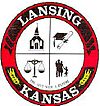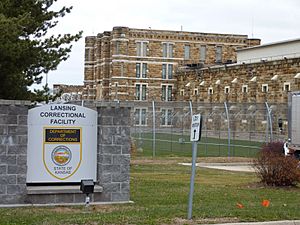Lansing, Kansas facts for kids
Quick facts for kids
Lansing, Kansas
|
||
|---|---|---|
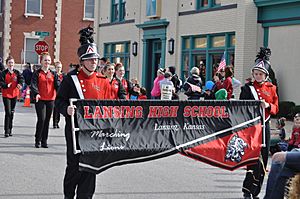
Lansing High School band marching in the 2015 Veterans Day Parade
|
||
|
||
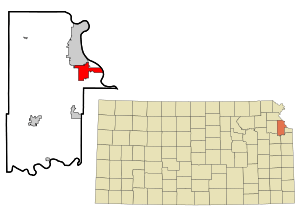
Location within Leavenworth County and Kansas
|
||
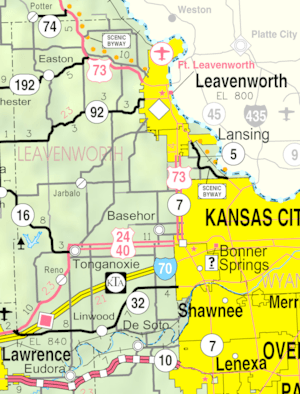
|
||
| Country | United States | |
| State | Kansas | |
| County | Leavenworth | |
| Platted | 1878 | |
| Incorporated | 1959 | |
| Named for | James Lansing | |
| Area | ||
| • Total | 12.41 sq mi (32.14 km2) | |
| • Land | 12.31 sq mi (31.88 km2) | |
| • Water | 0.10 sq mi (0.27 km2) 0.88% | |
| Elevation | 860 ft (260 m) | |
| Population
(2020)
|
||
| • Total | 11,239 | |
| • Density | 905.6/sq mi (349.69/km2) | |
| Time zone | UTC-6 (CST) | |
| • Summer (DST) | UTC-5 (CDT) | |
| ZIP code |
66043
|
|
| Area code | 913 | |
| GNIS ID | 485607 | |
Lansing is a city in Leavenworth County, Kansas, in the United States. It sits along the western side of the Missouri River. This river also forms the border between Kansas and Missouri.
As of the 2020 census, about 11,239 people live in Lansing. It is the second largest city in Leavenworth County. Lansing is also part of the larger Kansas City metropolitan area. The Lansing Correctional Facility, a major state prison, is located here.
Contents
Lansing's Story
Lansing is named after James Lansing, an early settler in the area. James Lansing was originally named William Lansing Taylor. He changed his name in 1862 when he joined the army during the Civil War. He worked as a hospital steward, helping care for sick and injured soldiers.
After the war, James Lansing worked at a new state prison in Kansas. He later left that job to open a general store. This store was very important because it also held the local post office and an apothecary (a place to get medicines). People called him "Doc Lansing."
In 1878, Doc Lansing and his friend John C. Schmidt bought about 90 acres of land. They divided this land into town lots, which means they planned out where streets and buildings would go. They named this new area the "Town of Lansing." However, Lansing did not officially become an incorporated city until 1959.
The Kansas State Penitentiary, now called the Lansing Correctional Facility, was approved in 1859. It is the oldest and largest prison in Kansas for adult male offenders. When a coal mine opened at the prison, Lansing became an important place for shipping coal.
In 2007, Money Magazine listed Lansing as one of the top 100 best places to live. It was ranked 88th on their list.
Where is Lansing?
Lansing is located on the western bank of the Missouri River. This river forms the border between Kansas and Missouri. The city of Leavenworth is just north of Lansing. Kansas City is also nearby, less than a half-hour drive to the southeast. U.S. Route 73, a main road, goes through Lansing.
The city covers a total area of about 12.50 square miles (32.37 square kilometers). Most of this area, about 12.39 square miles (32.10 square kilometers), is land. The rest, about 0.11 square miles (0.28 square kilometers), is water.
Lansing's Climate
Lansing has a climate with hot and humid summers. The winters are usually mild to cool. This type of weather is known as a humid subtropical climate. On climate maps, it is often shown as "Cfa."
People of Lansing
| Historical population | |||
|---|---|---|---|
| Census | Pop. | %± | |
| 1880 | 933 | — | |
| 1890 | 1,468 | 57.3% | |
| 1960 | 1,264 | — | |
| 1970 | 3,797 | 200.4% | |
| 1980 | 5,307 | 39.8% | |
| 1990 | 7,120 | 34.2% | |
| 2000 | 9,199 | 29.2% | |
| 2010 | 11,265 | 22.5% | |
| 2020 | 11,239 | −0.2% | |
| U.S. Decennial Census 2010-2020 |
|||
The 2020 United States census counted 11,239 people living in Lansing. There were 3,432 households and 2,566 families. The population density was about 913 people per square mile (352.6 per square kilometer).
Most of the people in Lansing, about 75.5%, are white. About 11.3% are black. Other groups include Native American, Asian, and Pacific Islander people. About 8.8% of the population identifies as being from two or more races. People of Hispanic or Latino background make up about 7.2% of the population.
In 2020, about 22.2% of the people in Lansing were under 18 years old. The average age in the city was 38.9 years.
Learning in Lansing
The public schools in Lansing are part of the Lansing USD 469 school district. This district serves over 2,000 students. There are four schools:
- Lansing Elementary School, for grades K–3
- Lansing Intermediate School, for grades 4–5
- Lansing Middle School, for grades 6–8
- Lansing High School, for grades 9–12
Famous People from Lansing
- John Bradford, who was a member of the Kansas House of Representatives.
- Paul Ranous Greever, who was a United States Representative for Wyoming. He was born in Lansing.
See also
 In Spanish: Lansing (Kansas) para niños
In Spanish: Lansing (Kansas) para niños


